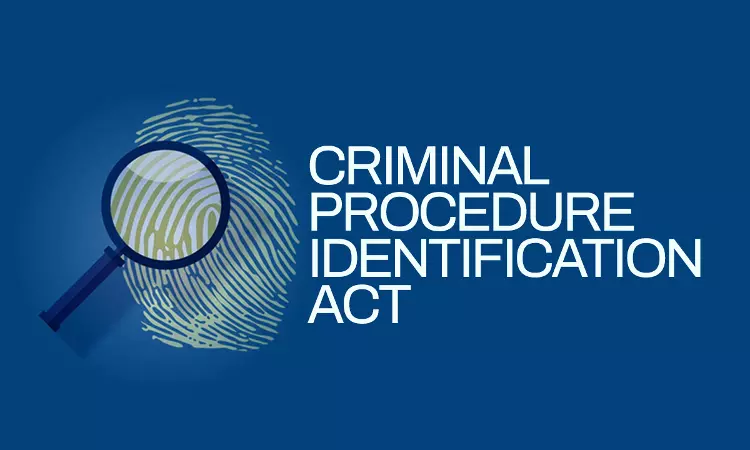Criminal Procedure Identification Act, 2022
Shreya Goswami
15 Dec 2022 10:32 AM IST

The recently enacted Criminal Identification Act, 2022 has spurred a lot of protests among human rights activists. This law replaces the colonial Identification of Prisoners Act, 1920 and authorizes the executive to take measurements of convicts and other persons for the purpose of identification and investigation in criminal matters. It also authorizes the preservation of records and data. The Criminal Procedure (Identification) Bill, 2022 was introduced in the Lok Sabha on 28th March 2022. It was passed by the Rajya Sabha on 6th April 2022 and it received the presidential assent on 18th April, thus becoming law.
The need to amend this law first arose when the Law Commission in its 87th Report, 1980 undertook a review of this legislation and recommended several amendments. This was done in the backdrop of the State of UP vs Ram Babu Misra, where the Apex Court had highlighted the need for amending this law.
Section 2(b) of the Act defines "measurements". Measurements include finger-impressions, palm-print impressions, foot-print impressions, photographs, iris and retina scan, physical, biological samples and their analysis, behavioral attributes including signatures, handwriting or any other examination referred to in section 53 or section 53A of the Code of Criminal Procedure, 1973. Section 53 of the Criminal Procedure Code, 1973 lays down that an accused may be examined by a medical practitioner on request of the police officer. Section 53 A (added by Amendment Act, 2005) specifically related to medical examination of a person accused of rape.
Who Is Required To Give Measurements?
Section 3 of the Act deals with the persons who shall be required to give the said measurements. Such persons include convicts, persons ordered to give security for good behavior and maintaining peace, and persons arrested in connection with any offence or detained under preventive detention law. This list of persons also prescribes an exception, i.e. if a person is arrested for any offence which is not against woman or child or punishable with imprisonment for a period not less than seven years, he may not be obligated to provide his biological samples. Any resistance to or refusal to allow the taking of measurements shall be an offence under Section 186 of Indian Penal Code.
The Act further authorizes National Crime Records Bureau to collect the record of measurements, store, preserve and destroy the records, process such record with relevant crime and criminal records, and share and disseminate such records with any law enforcement agency. Such records shall be digitally retained for a period of seventy-five years. However, where a person, who has not been previously convicted of an offence, is released without trial or discharged or acquitted by the court, after exhausting all legal remedies, all records of measurements so taken shall, be destroyed. It is to be noted that Section 5 of the Act empowers a Magistrate to direct a person to give measurements for the purpose of any investigation or proceeding under the Code of Criminal Procedure, 1973 or any other law.
Relevance Of The Act In Contemporary India
The Act provides for use of technology record appropriate body measurements of convicts, accused persons etc. In this modern age of technology it is essential for a governance to be as updated as the persons in conflict with laws and the rest of the world. Today, Artificial Intelligence is surpassing itself and evolving on an enormous speed; in such an age it becomes essential for the executive to be able to lay its hands on malefactors with speed and accuracy. The new law makes investigation more efficient and expeditious. This law also helps the investigating agencies to increase the ambit of persons and gather evidences which are legally admissible in the court of law. It is also to be noted that with time, the entire world is shrinking in context of access and communication. It has become far easier to escape and hide from the law and in such a scenario it becomes pertinent to modernize the investigations as well.
Constitutional Test Of The Bill
The Act raises a question as to privacy of such persons as guaranteed by Article 21 of the Constitution of India. The term measurement includes not only physical but also behavioral attributes and biological samples. Supreme Court in the recent case of Justice K.S.Puttaswamy v. Union of India has laid down a four-fold test of doctrine of proportionality and the new Act must pass the same.
It is also to be noted that the Act is not as clear as it should have been. The law directly deals with the fundamental rights under Article 14, 20 and 21, but unfortunately leaves a huge scope for arbitrary actions by the executive. Several loopholes arise on the plain reading of the Act, the most important being protection of rights of accused persons. The Act is an open invitation for violating the basic human rights of the convicts and accused, as with their immensely personal data stored with the government it will become even more difficult for them to return to society and start a healthy life.
Another loophole which the Act portrays is the lack of protection of the said data. The law clearly stated that information will be shared by NCRB with various investigating agencies, but does not provide for any safeguard and remedy is case the data is leaked, lost or reaches the wrong hands. However noble a thought may be to improve the investigations, the new law should have been more balanced and thoughtful of the "such persons" in order to meet the test of judicial review.
The author is an Academician , views are personal.


